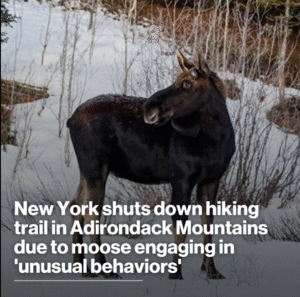New York officials have temporarily shut down a popular hiking trail in the Adirondack Mountains after a moose in the area began exhibiting what wildlife experts are calling “unusual behaviors.” The decision, made by the New York State Department of Environmental Conservation (DEC), comes after multiple reports from hikers who encountered the moose displaying signs of aggression, disorientation, and an apparent lack of fear toward humans.
The affected trail, located in a well-traveled part of the Adirondack Park, was closed out of an abundance of caution to protect both visitors and the animal itself. According to the DEC, the moose has been seen approaching hikers at close distances, circling campsites, blocking trail passages, and showing erratic movement patterns inconsistent with normal moose behavior. Some witnesses even claimed the moose charged in response to sudden noise or movement—something typically uncommon for these usually shy and solitary animals.
Moose are the largest land mammals in New York and are generally peaceful, avoiding human contact. While sightings in the Adirondacks are not uncommon, interactions of this nature are rare. The state’s wildlife officials say the behaviors could be caused by a variety of factors including illness, neurological conditions, or even human conditioning from previous feeding encounters.
“We’ve received several concerning reports over the last week,” said a DEC spokesperson. “The moose has become unusually active around heavily trafficked trails, and its behavior has escalated to the point where we believe public safety is at risk.”
One hiker, who encountered the moose near a trail junction, described the experience as “incredibly unsettling.” “It wasn’t afraid of us at all. It just stood in the middle of the path and stared, then started moving toward us,” the hiker said. “We backed away slowly, but it kept following us for a bit. I’ve never seen anything like it.”
As a precaution, wildlife biologists have been dispatched to observe the moose and assess its condition. They are working to determine whether the animal is sick, injured, or potentially habituated to human presence—something that can happen when wildlife is fed or otherwise interacts regularly with people. Such interactions can lead to loss of natural wariness, which increases the risk of unpredictable or dangerous behavior.
The closed trail runs through a region known for its dense forests, wetlands, and scenic views—making it a favorite among backpackers and wildlife enthusiasts. While the moose’s presence is usually seen as a thrilling sight for hikers, authorities stress that wild animals—even herbivores like moose—can pose serious threats when provoked, startled, or under duress.
Moose, particularly bulls and mothers with calves, can be aggressive if they feel threatened. They are massive creatures, with adult males weighing up to 1,500 pounds. Their sharp hooves and powerful legs can inflict serious injury if used in defense. Wildlife officials urge people to remain calm and maintain a safe distance if they encounter a moose in the wild.
The DEC has posted signs at all major access points to the affected trail, notifying hikers of the closure and encouraging them to use alternate routes. Rangers are also patrolling the area to enforce the closure and ensure no one attempts to bypass the barricades.
Meanwhile, wildlife experts continue to monitor the moose remotely using cameras and field observation. If the animal is found to be sick or injured, officials may consider tranquilization and relocation, or, if necessary, humane euthanasia. However, their goal remains to avoid confrontation and let the moose return to normal behavior if possible.
This incident has reignited conversations about responsible wildlife interaction in public lands. Feeding wild animals—even unintentionally by leaving behind food or trash—can alter their natural instincts and lead to dangerous outcomes. Conservationists are urging hikers to follow Leave No Trace principles, which include keeping a safe distance from wildlife, storing food securely, and never attempting to interact with or photograph animals up close.
Some locals and frequent hikers expressed disappointment over the trail closure but supported the decision. “It’s sad we can’t enjoy the area for now, but I understand it’s for everyone’s safety—including the animal’s,” said one Adirondack resident. “We need to remember that we’re guests in their habitat.”
Others see the situation as a learning opportunity. Schools and outdoor education programs in the region are already incorporating the event into lessons about wildlife behavior, conservation, and the importance of respectful coexistence with nature.
The trail closure is expected to last until officials can ensure that the area is safe for public use again. In the meantime, DEC encourages the public to report any additional sightings or unusual animal behavior in the region to help monitor the situation. Moose sightings, especially ones that deviate from normal patterns, can offer valuable insights into broader environmental changes affecting wildlife.
For now, the Adirondack trail in question will remain quiet, with only the sounds of wind, trees, and the occasional distant call of the forest’s largest inhabitant. What happens next will depend on the moose’s condition and behavior—and on how humans respond to this powerful reminder that the wilderness, while beautiful, is not ours to control.


